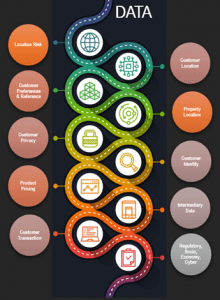Profitability is one of the ultimate underwriting goals for every insurance company. Is it necessary to phase out manual underwriting to clear the way for better profitability? The answer is ‘No.’ However, automated underwriting is beneficial as it helps the insurers increase the conversion ratio to increase the earned premium. But this leads to higher claims in the subsequent life cycle stage. For instance, the reactive process may not complement any proactive mechanism for predicting a red flag. Deceivers in the ecosystem can fabricate the facts to gain from the insurance. Automated underwriting can be a victim, in this case, nevertheless wholly depending on the size of the insurer and its risk-taking capabilities.
Small and medium-sized carriers, managing general agents, or managing general underwriters will have to live with the disease if they don’t spot the root cause through appropriate technology, process, or culture-driven solutions. We have noticed two trends in the recent years:
- Adoption / Preference to shared economy by consumers
- Mergers and Acquisition between Insurance companies
Recently, there has been a transition from an ownership-based economy to a shared economy in every business segment globally. Customers are eager to share their data against the value exchanged by the service providers. In insurance, it’s the safety and profitability that have attracted consumers to accept this new solution. However, the YoY percentage growth in insurance is still in the single-digit in few places (In 2020, total US insurance industry net premiums were written fell 3.1 percent. P&C net premiums written rose 2.1 percent, while Life&Annuity net premiums written fell 7.9 percent – Insurance Information Institute); the Insurance ecosystem is swiftly adopting this new business model. Millennials are the primary driving factor for on-demand insurance solutions. Different market research and analysts’ reports forecast growth of (CAGR) of more than 20-25% in the next five years on the usage-based insurance. This will impact the various coverage breakups and the volume of insureds or policyholders.
On-Demand Insurance can’t emphasize the historical data. Hence it is priced with loading than the traditional insurance coverages. The argument being the loading will at least supplement the claims cost in an adverse selection. Adverse selection can happen both for traditional-priced insurance coverages and on-demand insurance coverages. In either case, the insurers can trust data-driven architecture deployed at the early risk identification stage for better risk-selection results.
In the current digital age, customers rely on social media platforms. Structured and unstructured data are abundant for the insurers to refine and build insights. It would further help in future price optimization and better risk selection. In this context, the end consumer will have the right to ask for a better price or service and an exercise right on their data. A working committee at the United States National Association of Insurance Commissioners (NAIC) is one such unit that reviews the use of external data and analytics in accelerated life underwriting to guide others.
Mergers and acquisitions have regularly created the demand for an all-inclusive ecosystem creation to provide an end-to-end solution to the customers. For example, recently, there was a strategic alliance between a UK-based international insurance group and an International MGA to offer optimal data-driven solutions for the purchase process to its clients. Artificial Intelligence, Big Data, and Machine Learning solutions apply programs that automatically read, sort, assign, notify and prioritize insurance business contracts.
The industry players are also working together to create a consortium for data sharing, which will help each other with their business processes and risk management, such as better customer experience, fraud control, and insurance penetration. One such initiative by the National Insurance Crime Bureau (NICB) is the ‘Geospatial Insurance Consortium.’
The recent pandemic has transformed the insurance industry digital, where the company’s core or non-core units have fine-tuned their processes aligning with the digital strategy. Now, it is the time to leverage the digital scale and explore analytical capabilities around the data stream to evolve and extend sustainable business models.
If carriers want to respond to the above, we need to refine these trends to define an actionable plan. Here are some questions that will help in goal setting:
- What would be an ideal risk-free underwriting processing time for issuing a policy as per quoted price without any loading?
- What would be an ideal acceptable loading range for a non-standard risk profile? Can system make decision or require human underwriting intervention to accept/reject/defer the quote?
- What percentage of improvement in quality is expected from risk demarcation or identification?
- What percentage of improvement is expected from underwriting operating expenses when investment in data driven technology is made at the entry stage?
- What’s your current real-time data-driven experience level? Is further improving consumer/distributor experience expected?
While all the above questions are relevant, one question may arise on better distributor experience and where the consumer prefers to seek advice; traditional face-to-face or direct/virtual channel.

The above question can be answered through behavioral Science. This has time and again reminded of the different responses of the consumer in various circumstances. As per Swiss Re’s 2021 APAC COVID-19 consumer survey – 1 in 2 respondents are interested in purchasing through insurers’ online websites and apps in the future. This shows that the consumer preference for offline mode is still there. Thus, the insurance industry is expected to operate hand-in-hand with the traditional and improvised offering model. Carriers would continue focusing on enabling technology enhancement for its intermediary partners in ‘Digital Distribution to Digital Policy Expiry’. This will accrue a better distributor experience and add to the bottom line. But the fact will remain the same – Data is the pillar for the answers to the above questions; Speed – Accuracy – Profitability – Experience.
Many insurers have already created the data architecture that aids every insurance business process. The risk administrators already accept the preventive way of underwriting philosophy.
The practice now needs to get used to the religious use of analytical solutions. Whether manual or automated or a hybrid underwriting practice, the model needs to always look for ways to capture enough information to support its pricing or rating decisions. The availability of matured gravity of each data element can attract more data and help the underwriting function avoid adverse selection, future claims, smart reserving or fraudulent claims, and better capital management. It should create a legacy for the future sales/cross-sales pipeline.
When a process runs very fast, it may lose focus on various things. For example, when a plane/jet flies, we see things only during take-off and landing. On the other hand, a hot air balloon rides slowly and thoroughly exposes various elements around the landscape until one reaches a height. The current insurance industry follows a blended approach for the underwriting cycle when an insurance automation process can be intervened by a manual review and a preventive algorithm gauge underwriting intensity with underwriting complexity. Applying the analytical approach early in the insurance life cycle and when there is a critical data change would help the insurers avoid undesirable claims or losses and accrue profitability through better risk identification, price optimization, proactive risk selection advice, and consumer trust through value experience.




